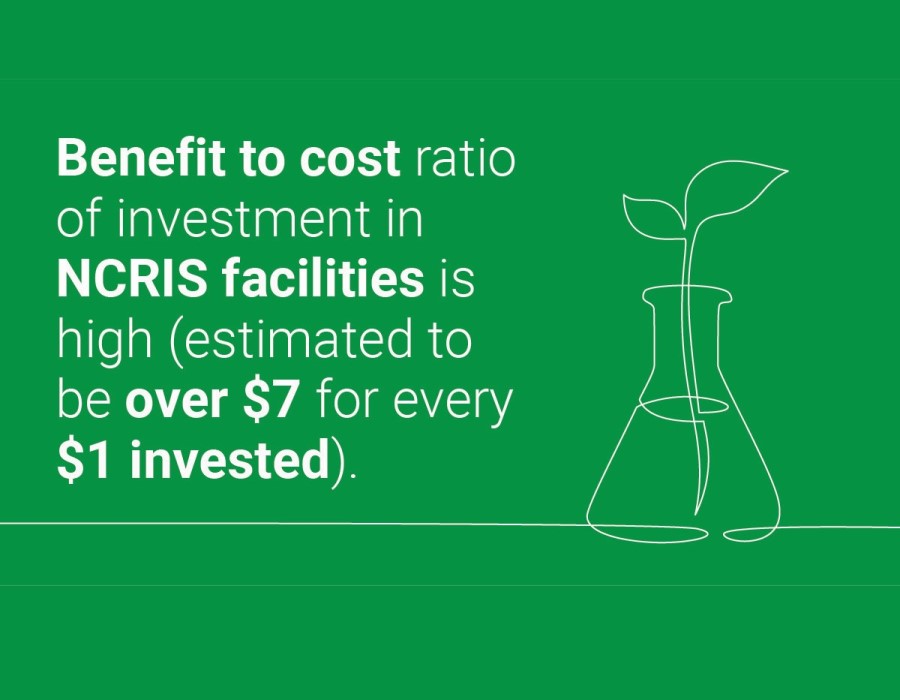Recently, a number of research infrastructure organisations from the NCRIS community, including the Atlas of Living Australia, commissioned Lateral Economics (LE) to assess the positive impacts of NCRIS for Australian society and the environment. The report identified ways in which NCRIS funding has and will continue to support the Australian community and economy.
Powerful economic findings

National Collaborative Research
Infrastructure (NCRIS) spending
and economic growth found the direct benefit of investment in NCRIS is calculated to be above a $7 return for every $1 invested, a return on investment (ROI) of 7.5:1. By 2022-23 the investment could support the employment of an additional 1,750 scientific and technical staff, support staff, and supply chain and industry staff -. These benefits along with others outlined in the report indicate the significant impact NCRIS has made on Australia’s economic security. The report concluded:
“Based on economic theory and evidence from the time of the GFC to present, we can think of few approaches to providing additional stimulus to the Australian economy that are more cost effective than increasing investment in NCRIS.”
NCRIS delivers
The impact of NCRIS is clear, however the program itself is not often centre stage. From supercomputers and microscopes, to data collection and software platforms NCRIS provides the infrastructure that supports Australia’s scientists.
The result is a network of world-class research facilities that are driving innovation and research in Australia and internationally. This network is made up of 22 NCRIS projects, which link over 200 institutions employing more than 1,900 highly skilled researchers and technical experts. This interconnected infrastructure and the specialist teams who run NCRIS programs allow Australia to meet the key challenges outlined in the UN sustainability goals and tackle some of the biggest scientific and societal challenges we face today. These have been highlighted in the Lateral Economics report as:
 | Bushfire preparedness. With a range of sensors across Australia supported by NCRIS facilities such as TERN and AURIN, Australia can be better prepared for bushfire threats in the future. |
 | Cyclone warnings. IMOS is providing rich, high frequency data from Australia’s surrounding oceans which can provide early warning signs of cyclones, not to mention ocean acidification and sea level rise associated with climate change. |
 | Population health. A range of NCRIS facilities (e.g., PHRN, Phenomics Australia, Bioplatforms Australia, Therapeutic Innovation Australia) are helping to improve the health of Australia’s population. |
| Understanding the building blocks of reality. NCRIS facilities such as Microscopy Australia, National Imaging Facility, ANSTO, and Astronomy Australia are contributing to world leading research on the building blocks of the universe and of life. | |
 | Monitoring biodiversity. Australia’s unique biodiversity is being monitored, described and protected by the Atlas of Living Australia (ALA), BioPlatforms Australia, IMOS and TERN. In particular, ALA is our national biodiversity data infrastructure. It integrates and delivers fundamental data on Australia’s plants, animals and fungi to support ecosystem assessment, monitoring and planning. |
 | Boosting crop yields and resilience. The Australian Plant Phenomics Facility contributes fundamental services in the effort to improve crop yields and crop resilience with genomic and molecular characterisation performed through Bioplatforms Australia. |
| Deriving value from data. ARDC, Pawsey Supercomputing Centre and the National Computational Infrastructure enable data from many fields of research across a wide range of scales to be stored, curated, managed and analysed. | |
| Understanding the earth.AuScope improves our understanding of fundamental earth science and enables a range of benefits including substantial reductions in the cost of and more effective resource exploration. | |
 | Advanced manufacturing. The Australian National Fabrication Facility (ANFF) and Therapeutic Innovation Australian (TIA) provide industry and the wider community with access to cutting-edge advanced manufacturing technologies. Furthermore, NCRIS organisations such as Astronomy Australia are involved in advanced manufacturing activities. |
Selected examples of major benefits of NCRIS-supported infrastructure to the Australian community from the National Collaborative Research Infrastructure (NCRIS) spending and economic growth report, June 2021.
Icon credits: The Noun Project (top to bottom), Kevin, OCHA Visual, Nociconist, Sergey DemushkinImage, Felipe Perucho, Abdulloh Fauzan, Gregor Cresnar, Lluisa Iborra and iconcheese
This question highlights the direction in which Australia’s science must head. NCRIS will be a key driver of this interdisciplinary and impact driven future.
NCRIS as an enabler of international collaborations and science diplomacy
The report describes how NCRIS also provides opportunities for international engagement and cooperation delivering ‘science diplomacy’.
The ALA is an excellent example of this. In its role as the Australian node of the Global Biodiversity Information Facility, the ALA helped to establish the Living Atlases program in 2016, by which other nations (now 24) can establish their own biodiversity data systems.
“Software originally developed by our Australian team is now in use by countries around the world to help manage their national biodiversity databases,” said Dr Andre Zerger, Director, Atlas of Living Australia.
“Our international collaborations increase the extent to which foreign researchers include Australia in their research. This generates better knowledge about Australia, including where it ensures Australia is included in cross-country science.”
Blog authors
On behalf of the NCRIS Communications Network, thank you to Philomena Manifold (AuScope), Jo Curkpatrick (Australian Plant Phenomics Facility) Romy Pearse (Astronomy Australia), Nicola Tew (Population Health Research Network) and Karina Nunez Machado (Pawsey).
More information
If you would like to know more about the Lateral Economics report, please contact Dr Merran Smith (University of Western Australia).
Further reading
Download the report: National Collaborative Research Infrastructure (NCRIS) spending and economic growth by Lateral Economics, 2021